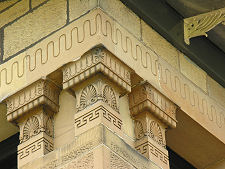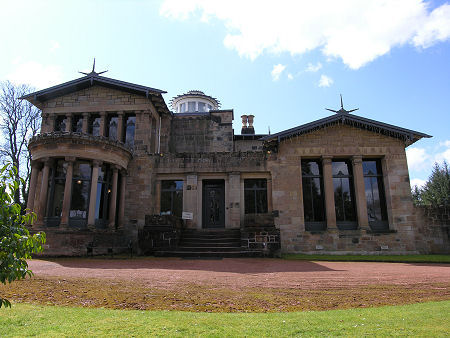 The Front of Holmwood House |
Holmwood House can be found just over three miles south of central Glasgow and a little south of what was, at the time, the village of Cathcart. It was built in 1857-8 at a cost of £3,600 for the businessman James Couper. James and his brother Robert ran the Millholm Paper Mill, which was located on the nearby banks of the White Cart Water, and both James and Robert had houses built close to the mill.
So far, this is a pretty unexceptional story of Glasgow in the 1800s. Robert Couper's house, Sunnyside, was built first, and until it was demolished at the end of the 1960s, this fairly ordinary Gothic villa stood a little to the east of Holmwood House. James Couper, however, wanted something a little more unusual. As a result he commissioned, arguably, Glasgow's second most famous architect, Alexander "Greek" Thomson, to design a unique villa for him. What emerged is usually regarded as Thomson's finest domestic building: and as a result Holmwood House has become a shrine to architecture, and to Alexander Thomson's architecture in particular, and attracts visitors from every corner of the globe.
Alexander Thomson was born in 1817. At the age of 12 he was working in a lawyer's office, and at the age of 17 he was taken on as an apprentice by the architect Robert Foote. Alexander became fascinated by exotic architectural designs and motifs, especially from Classical Greece, Egypt, Assyria and India. Although he never travelled to the lands from which he was to draw his inspiration, Alexander "Greek" Thomson's unique style was received with enthusiasm by enough patrons in the dynamic Glasgow of the mid-1800s to keep him in very lucrative employment.
Thomson went on to become a founder member of both the Glasgow Architectural Society and the Glasgow Institute of Architects, and he proved highly influential in helping shape the Glasgow that blossomed in the 1800s. He also exercised a considerable influence over those who followed him. After his death in 1875, the Alexander Thompson Travelling Studentship was established in his memory. The second winner of the studentship was the man who was to eclipse Thomson and become Glasgow's most famous architect, Charles Rennie Mackintosh.
Many of Thomson's buildings were demolished during Glasgow's era of "improvement" from the 1950s to the 1970s, but others do survive. Few survive as completely, however, as Holmwood House. And few reveal so tellingly the aspect of Thomson's work that set him apart from many of his contemporaries, yet placed him in a direct line of Scottish architects that ran from Robert Adam to Charles Rennie Mackintosh: all three were as interested in internal detail and decor as they were in the exterior of their buildings.
James Couper died in 1877, and his second wife Catherine lived at Holmwood until her death in November 1908. In 1909 it was purchased by Mrs Anne Simpson, the widow of a Glasgow merchant, who lived here until 1916. Holmwood was owned by the Stenhouse family from 1916 to 1919, and it was then purchased by James Gray, a businessman and local politician who welcomed Lloyd George to the house in 1928. Another notable Glasgow businessman and local politician, Thomas Patterson, purchased the house in 1931, and the Pattersons lived here until 1953.
Holmwood was then owned for five years by the McElhone family, before being purchased by The Sisters of Our Lady of the Mission in 1958 and used in support of a primary school they established behind the house in an area now occupied by the car park. After the school moved to new premises in 1992, the Sisters continued to live and work at Holmwood until 1994, when they granted a developer an option over the property. Had it not been for the consistent refusal of Glasgow City Council to grant planning permission, the developer would have built 93 flats and houses in the grounds of Holmwood House. But that was prevented, and as a result the National Trust for Scotland, with the support of a wide range of other bodies, was able to purchase the house. After restoring it as far as possible to its original 1858 appearance, the NTS opened Holmwood House to the public in 1998.
Visitors to Holmwood House today probably benefit from the experience in direct proportion to the extent to which they are interested in the life and work of Alexander "Greek" Thomson. What they find at first glance seems from the outside to be a surprisingly modern-looking house, quite modest in scale, and heavily adorned to a staggeringly detailed level.
The interior of the house is every bit as deeply adorned as the exterior, but the feel is of somewhere considerably older than the outside leads you to expect. There are two main rooms on the ground floor. The parlour houses a remarkable bay window that seems to connect the house to the surrounding garden. The dining room is in many ways the most ornate room in the house, and the NTS has been systematically restoring it to its original grand design. The first floor drawing room is an amazingly light room, with nearly floor to ceiling windows occupying more than one whole wall, and large mirrors placed on the other three walls. This, and the dining room, would have been the key venues within the house for "corporate entertainment" during the period when Holmwood was owned by a succession of notable Glasgow businessmen.
 Cupola Above the Staircase |

|
|
|
Visitor InformationView Location on MapSTB 4 Star Visitor Attraction 61-63 Netherlee Road, Glasgow, G44 3YU. Tel: 0141 571 0184. holmwood@nts.org.uk Grid Ref: NS 585 597 www.nts.org.uk NTS: House Web Page Opening Hours Admission Accessibility What3Words Location: ///dined.pocket.update |
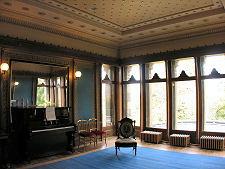 Drawing Room |
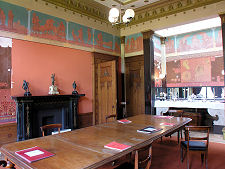 Dining Room |
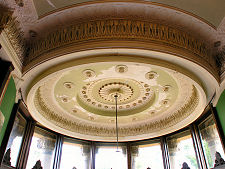 Bay Window Ceiling, Parlour |
 Entrance Hall |
 Kitchen |
 Bedroom |



